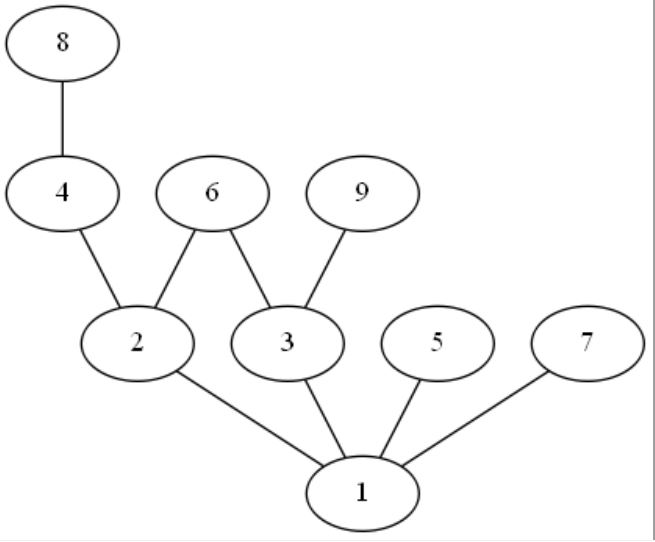@Arbalest-Laevatain
2018-05-28T07:54:57.000000Z
字数 5803
阅读 964
离散数学作业07
离散数学作业
第七章练习题
第十五题
(1)图A

(2)图B
关系计算
求关系的定义域
//求定义域#include <iostream>using namespace std;//定义一种关系class R{public:int s1,s2;//int* next;};//定义一个同余关系int mmod(int a,int b){if (a%4==b%4)return 1;elsereturn 0;}//定义两个非空集合A、Bint A[10]={1,2,3,4,5,6,7,8,9,10};int B[5]={1,2,3,4,5};int main(int argc, char** argv) {R*g=new R[50];int n=0;for (int i=0;i<10;i++){for (int j=0;j<5;j++){if (mmod(A[i],B[j])){g[i].s1=A[i];g[i].s2=B[j];n++;//cout<<(g[i].s1)<<endl;}}}//cout<<n<<endl;for (int i=0;i<n;i++){int t=g[i].s1;for (int j=0;j<n;j++){if (j!=i && g[j].s1==t){g[j].s1=0;}}}cout<<"该关系的定义域为:"<<endl;for (int i=0;i<n;i++)if (g[i].s1)cout<<g[i].s1<<" ";cout<<endl;delete[]g;return 0;}
求关系的值域
#include <iostream>using namespace std;//定义一种关系class R{public:int s1,s2;//int* next;};//定义一个同余关系//模4同余int mmod(int a,int b){if (a%4==b%4)return 1;//满足关系则返回1,否则返回0elsereturn 0;}//定义两个非空集合A、Bint A[10]={1,2,3,4,5,6,7,8,9,10};int B[5]={1,2,3,4,5};int main(int argc, char** argv) {R*g=new R[50];int z[20]={0};int *z0=z;int n=0,i;for (i=0;i<10;i++){for (int j=0;j<5;j++){if (mmod(A[i],B[j]))//判断是否满足关系{g[i].s1=A[i];g[i].s2=B[j];n++;//cout<<(g[i].s2)<<'\n';z[n]=B[j];z0++;}}}//cout<<n<<endl;int m=0;//消除重复的项for (i=0;i<n;i++){int t=z[i];for (int j=0;j<n;j++){if (j!=i && z[j]==t){z[j]=0;}}}cout<<"该关系的值域为:"<<"\n";for (i=0;i<n;i++)if (z[i])cout<<z[i]<<" ";cout<<"\n";delete[]g;return 0;}
求关系的逆
#include <iostream>using namespace std;//定义一种关系class R{public:int s1,s2;//int* next;};//定义一个关系R g0[]={{1,2},{2,3},{3,1}};int main(int argc, char** argv) {R g[3];//获取关系集的长度int l=(sizeof(g0)/sizeof(R));for (int i=0;i<l;i++){g[i].s1=g0[i].s2;g[i].s2=g0[i].s1;}cout<<l<<'\n';cout<<"关系的逆为:";for (int i=0;i<l;i++){cout<<"<"<<g[i].s1<<","<<g[i].s2<<">"<<",";} cout<<"\n";return 0;}
求关系的复合运算
#include <iostream>using namespace std;/* run this program using the console pauser or add your own getch, system("pause") or input loop *///定义一种关系class R{public:int s1,s2;//int* next;};//定义两个关系R g1[]={{1,2},{2,3},{3,1}};R g2[]={{1,3},{2,1},{3,2}};int main(int argc, char** argv) {R g[5];//获取关系集的长度int l=(sizeof(g1)/sizeof(R));for (int i=0;i<l;i++){for (int j=0;j<l;j++){g[i].s1=g1[i].s1;if (g2[j].s1==g1[i].s2)g[i].s2=g2[j].s2;}}cout<<l<<'\n';cout<<"关系的复合运算为:";for (int i=0;i<l;i++){cout<<"<"<<g[i].s1<<","<<g[i].s2<<">"<<",";} cout<<"\n";return 0;}
判定关系是否是自反
#include <iostream>using namespace std;//定义一种关系class R{public:int s1,s2;//int* next;};//定义一个基数为n的非空集合 aconst int n=3;int a[n]={1,2,3};//定义一个非空集合a上的关系R g0[n]={{1,1},{2,2},{3,3}} ;R g1[n]={{1,2},{2,3},{3,1}};//判定函数int reflex(R *g){int l=sizeof(g)/sizeof(R);int m=0;for (int i=0;i<l;i++){for (int j=0;j<l;j++){if (g[i].s1==g[i].s2 && g[i].s1==a[j])m++;}}if (m==l)return 1;elsereturn 0;}int main(int argc, char** argv) {if (reflex(g1))cout<<"是自反关系"<<'\n';elsecout<<"不是自反关系"<<'\n';return 0;}
判定关系是否反自反
#include <iostream>using namespace std;/* run this program using the console pauser or add your own getch, system("pause") or input loop *///定义一种关系class R{public:int s1,s2;//int* next;};//定义一个非空集合 aconst int n=3;int a[n]={1,2,3};//定义一个非空集合a上的关系R g0[n]={{1,1},{2,2},{3,3}} ;R g1[n]={{1,2},{2,3},{3,1}};//判定函数int antireflex(R *g){int m=0;for (int i=0;i<n;i++){if (g[i].s1!=g[i].s2)m++;}if (m==l)return 1;elsereturn 0;}int main(int argc, char** argv) {if (antireflex(g0))cout<<"是反自反关系"<<'\n';elsecout<<"不是反自反关系"<<'\n';return 0;}
判定关系是否为对称
#include <iostream>using namespace std;/* run this program using the console pauser or add your own getch, system("pause") or input loop *///定义一种关系class R{public:int s1,s2;//int* next;};//定义一个非空集合 aconst int n=3;int a[n]={1,2,3};//定义一个非空集合a上的关系R g0[n]={{1,1},{2,2},{3,3}} ;R g1[n]={{1,1},{2,2},{3,1}};//判定函数int symm(R *g){R g0[n];//int l=sizeof(g)/sizeof(R);int m=0;for (int i=0;i<n;i++){g0[i].s2=g[i].s1;g0[i].s1=g[i].s2;}for (int i=0;i<n;i++){for (int j=0;j<n;j++){if (g[i].s1==g0[j].s1 && g[i].s2==g0[j].s2)m++;}}if (m==n)return 1;elsereturn 0;}int main(int argc, char** argv) {if (symm(g1))cout<<"是对称关系"<<'\n';elsecout<<"不是对称关系"<<'\n';return 0;}
判定关系是否为反对称
#include <iostream>using namespace std;//定义一种关系class R{public:int s1,s2;//int* next;};//定义一个非空集合 aconst int n=3;int a[n]={1,2,3};//定义一个非空集合a上的关系R g0[n]={{1,2},{2,1},{3,3}} ;R g1[n]={{1,1},{2,3},{3,1}};//判定函数int antisymm(R *g){R g0[n];//int l=sizeof(g)/sizeof(R);int m1=0,i;int nn=n;for (i=0;i<n;i++){g0[i].s2=g[i].s1;g0[i].s1=g[i].s2;}for (i=0;i<n;i++){if (g[i].s1==g[i].s2)nn--;int m2=0;for (int j=0;j<n;j++){if (g[i].s1!=g[i].s2){if ((g[i].s1==g0[j].s1 && g[i].s2==g0[j].s2)==0)m2++;}}if (m2==n)m1++;}if (m1==nn)return 1;elsereturn 0;}int main(int argc, char** argv) {if (antisymm(g0))cout<<"是反对称关系"<<'\n';elsecout<<"不是反对称关系"<<'\n';return 0;}
判定关系是否为传递
//判断函数*** 判断一个关系是否具有传递性。* pA: 原始集合* pBinaryRelationR: 卡氏积集合,该集合是一个pA上的二元关系* 如果pBinaryRelationR具有传递性,则返回true,否则返回false*/boolean IsTransitive(pOriginalSet pA, pCartersianSet pBinaryRelationR){pOriginalSetElem First1,Second1;pOriginalSetElem First2,Second2;pCartersianSet pB=copyCartersianSet(pBinaryRelationR);pCartersianSet pC=copyCartersianSet(pBinaryRelationR);if(!isNullCartersianSet(pBinaryRelationR)){for(resetCartersianSet(pC);!isEndOfCartersianSet(pC);nextCartersianSetPos(pC)){First1=getFirstElemOfOrderedCouple(getCurrentCartersianSetElem(pC));Second1=getSecondElemOfOrderedCouple(getCurrentCartersianSetElem(pC));for(resetCartersianSet(pB);!isEndOfCartersianSet(pB);nextCartersianSetPos(pB)){First2=getFirstElemOfOrderedCouple(getCurrentCartersianSetElem(pB));Second2=getSecondElemOfOrderedCouple(getCurrentCartersianSetElem(pB));if(isEqualOriginalSetElem(First2,Second1)){if(!isInCartersianSet(pBinaryRelationR,createOrderedCouple(First1,Second2)))return false;}}}}else return true;return true;}
第二十题
解:
画出P的子集T的哈斯图,易得上界为3,4,5的公倍数
下界为1,最大上界为1,最小上界为60.
第二十一题
证明:
自反性:
根据定义有,
既有,满足自反性
反对称性:
对,若有时,仅当时,,满足反对称性
传递性:
若,即,即,满足传递性
综上,是偏序集
六例关系
等价关系两例
- 设集合为一条水准路线中的测站点,关系为精度相同的杆件测站
- 设是实数域上的矩阵组成的集合,关系为矩阵,的行数列数相同且同秩
偏序关系两例
3、设集合中的每一个元素都是一位公司职员,关系为上司给下级分派任务
4、设为我们国家的大地控制网中的各级导线,关系为从已知点设计测量路线对未知地域的测量
5、 设为数据结点集,关系为链表关系。从头结点开始,一个指向一个
6、设为决策分类树集合,关系为分类结果相同的决策分类树

